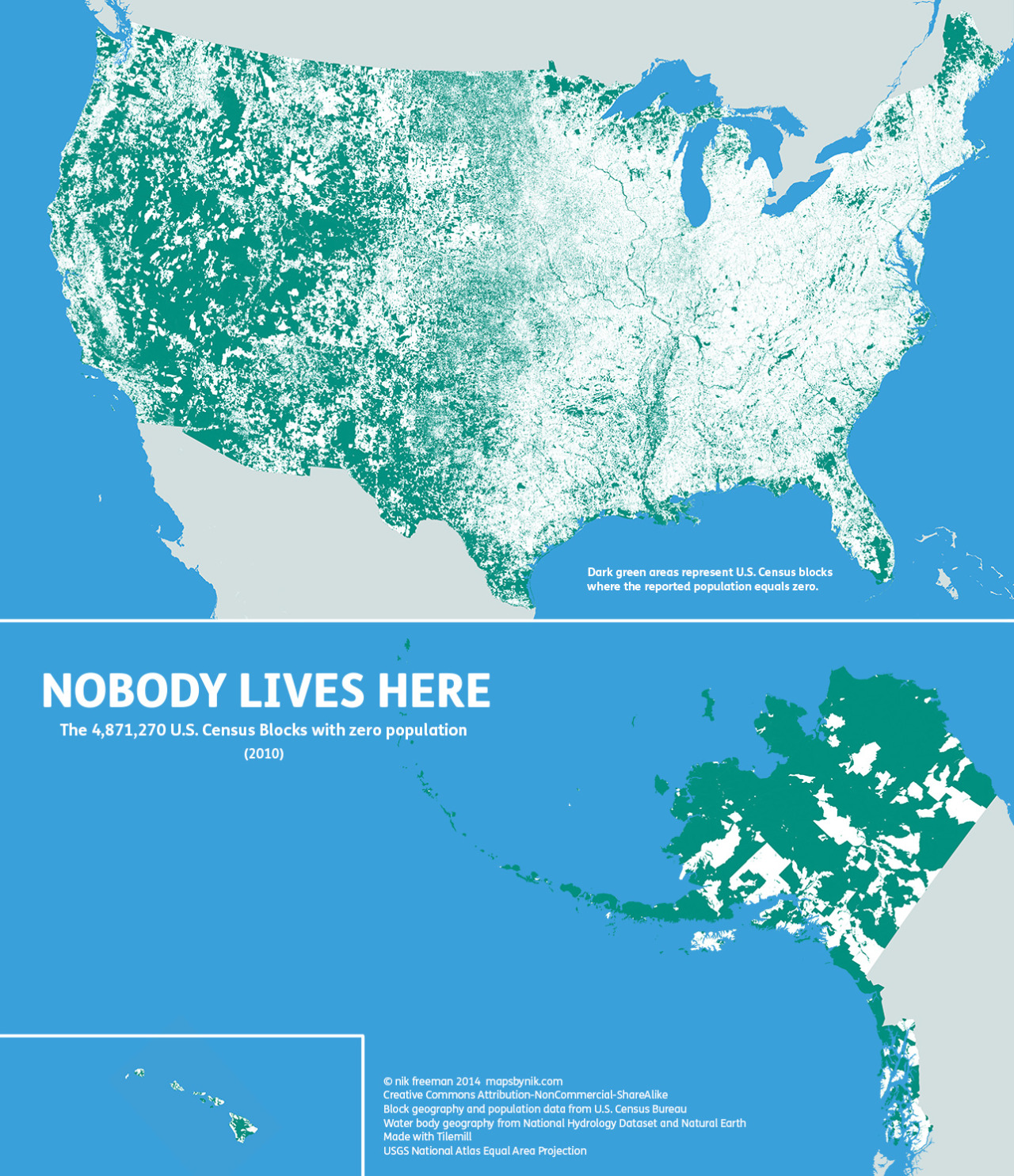General Discussion
Related: Editorials & Other Articles, Issue Forums, Alliance Forums, Region ForumsNobody lives here: The nearly 5 million Census Blocks with zero population
A Block is the smallest area unit used by the U.S. Census Bureau for tabulating statistics. As of the 2010 census, the United States consists of 11,078,300 Census Blocks. Of them, 4,871,270 blocks totaling 4.61 million square kilometers were reported to have no population living inside them. Despite having a population of more than 310 million people, 47 percent of the USA remains unoccupied.
Green shading indicates unoccupied Census Blocks. A single inhabitant is enough to omit a block from shading
The map tends to highlight two types of areas:
places where human habitation is physically restrictive or impossible, and
places where human habitation is prohibited by social or legal convention.
Water features such lakes, rivers, swamps and floodplains are revealed as places where it is hard for people to live. In addition, the mountains and deserts of the West, with their hostility to human survival, remain largely void of permanent population.
Of the places where settlement is prohibited, the most apparent are wilderness protection and recreational areas (such as national and state parks) and military bases. At the national and regional scales, these places appear as large green tracts surrounded by otherwise populated countryside.

http://mapsbynik.tumblr.com/post/82791188950/nobody-lives-here-the-nearly-5-million-census?utm_source=digg&utm_medium=email
JNelson6563
(28,151 posts)Gormy Cuss
(30,884 posts)but as a native, I know it's empty because it's owned mostly by lumber companies. There are a couple of large natural preservation areas like Baxter State Park and the Allagash waterway but the bulk of the unorganized townships are lumber zones.
hfojvt
(37,573 posts)you don't expect people to live in a cornfield, do you? (or do the authors of this piece?) The US is 3.794 million square miles with 11.078 million blocks that means an average "block" is .34 square miles or 217.6 acres.
Where I come from, in South Dakota, an average farm is 640 acres. Even in Wisconsin many farms are bigger than 218 acres.
So in Dakota, Nebraska, Iowa, Wisconsin, and probably any other rural area, you will have a farm, with a home and a barn taking perhaps 3 acres and the rest of the acreage will be cornfields, or pasture - an unoccupied block.
Now back in the 1800s and earlier, farmers used to eke out a living on 40 acres. That was the size of the tract one of my ancestors bought in 1861, and then he later bought 80 more acres. Still leaving the total size of his land as less than one census block. But with the costs of modern farming those farms have been consolidated in much larger tracts and the people have moved to the big cities to live, leaving the rural blocks vacant as more and more people pack into the urban blocks.
At least some of that vacant land just means - big farms.
Jesus Malverde
(10,274 posts)Looking at that map, seeing states like Nevada almost all green puts some things in context.
![]()
hfojvt
(37,573 posts)in fact, the urbanization is shown by the other vacant land.
My own county of residence would be 1,376 census blocks. In this county though, about 70% of the population lives basically in ONE urban area. About 85% lives in that urban area, within a mile of that city and in two other small towns of 5,000 people.
And even in states like Minnesota and Colorado and Nebraska twenty years ago - about 50% of the population of the state lives in the largest metro area. As people pack into metro areas that leaves other areas more vacant.
For some reason, Germany is growing differently. For example, Richland Center, Wisconsin and Spaichingen, Deutschland were about 5,000 people in the year 1900. Now, 100 years later, Richland Center is still about 5,000 people but Spaichingen has grown to 12,000 people.
In America, the young people of Richland Center and Richland County are forced (or choose) to move to places like Madison, LaCrosse, the Twin Cities, Milwaukee, etc. to find jobs, to make a living. In Germany they apparently have not had to do that.
Although, also Spaichingen is a mere 11 kilometers from Tuttlingen (population 33,000) and 13 kilometers from Rottweil (population 24,000) and even closer to Trossingen (15,000 people). Richland Center is 40-60 miles from other cities. So Germany is more like Connecticut or New Jersey than it is Wisconsin, but those states are basically exurbs of NYC.
Jesus Malverde
(10,274 posts)There is obviously been a huge shift with the move away from an agricultural society.
In some ways to me the internet would have made rural living easier, I guess people go where the jobs are. It's a little silly but I watched some videos on youtube watching the modern farmer harvest, it's amazing what technology has achieved.
Comrade Grumpy
(13,184 posts)I'll be driving from eastern South Dakota to northern California in a few days. I'll be hitting a whole lot of empty census tracts. It's soothing.
2naSalit
(86,577 posts)Compare the maps...

http://nationalatlas.gov/printable/fedlands.html#list